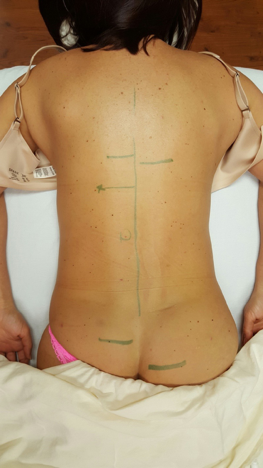One of the main professional tasks for a Medical Massage therapist is to detect the presence of reflex zones in skin (cutaneous reflex zones), fascia (connective tissue zones), skeletal muscle (hypertonus, TP, myogelosis) and periosteum (perisotal TP) and eliminate them using the tools of Medical Massage to target pathological changes formed in different levels of soft tissues. No other profession in medicine does that but this is exactly what Medical Massage is all about.
The body gives a lot of clues to the therapist who knows how to read and interpret them. Sometimes a piece of information during interview, visual signs or palpatory examination give the Medical Massage therapist an important piece of information which directs him or her to choose the correct treatment option. Our former student and now CMMP Curt Lezanic, LMT illustrates this with his contribution to the News From the Clinics section of the Journal of Massage Science.
Ross Turchaninov, Editor in Chief
HOW TO DEAL WITH 12 YEAR-OLD CUTANEOUS REFLEX ZONES
Last Friday evening a 49 year-old female patient came in complaining about hip irritation. She had been dealing with this irritation for 12 years and relying on chiropractic care to resolve the issue. After reviewing her symptoms, I asked her to remove her blouse and lay face down on my massage table. I reentered the room fully expecting to find that the lumbar erectors or quadratus lumborum and/or piriformis muscles were compromised and more than likely had one or more pathological conditions. To my surprise, there were no real pathological issues in any of these muscles.
Now I had to reassess my initial thoughts. I examined her back and found that the skin was very glossy and reflected light to a fairly significant degree. Please note the attached picture.

Hopefully, you can see how reflective the skin was. This picture was taken with no flash. It was taken under normal fluorescent ceiling lighting.
At this point, I was fairly certain that what I was presented with was a cutaneous reflex zone. I began to palpate the skin on each side of the spinal column. As I palpated the skin the patient immediately reacted. If you look closely at the picture the two green lines on the buttocks marked the lowest point on each side of the spine that the patient felt irritation. The upper green lines marked the highest point on the back where the patient felt any irritation. Now if you are able to see a third line on the right side of the patient’s back with an X that marks an area of the skin that was particularly sensitive. At this point, I began to look for a cutaneous trigger point.
I found the cutaneous trigger point and marked it with a circle. I then resolved the trigger point using the techniques shown on page 97 of the Medical Massage Volume I book and did superficial friction to the entire cutaneous reflex zone.
I stepped out of the room so that the patient could dress. When she opened up the door she told me that I had resolved an issue that she had been dealing with for twelve years.
As I am in the process of looking to hire an additional therapist, this patient had volunteered to act as the model so that I could access the basic skills of an interviewee. This happened four days after the treatment for her cutaneous reflex zone. At that point, I asked her about her symptoms. She said all symptoms were still resolved. I examined her back for glossy skin and any reoccurrence of the reflex zone. I am happy to report that her skin no longer reflects light and the reflex zone has been eliminated.
Curt Lezanic, San Antonio, Texas Clinic
Category: Blog
